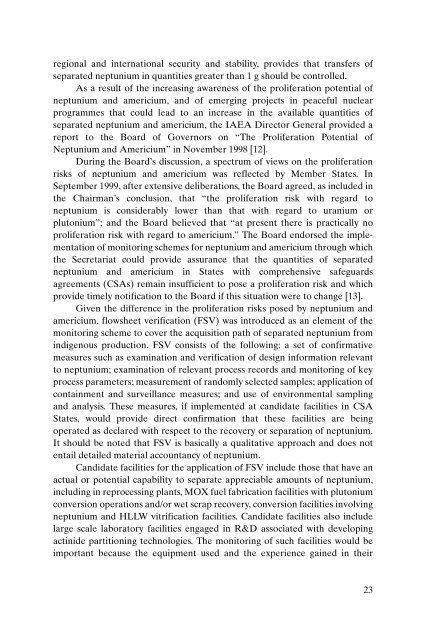TRS435_web
TRS435_web
TRS435_web
Create successful ePaper yourself
Turn your PDF publications into a flip-book with our unique Google optimized e-Paper software.
egional and international security and stability, provides that transfers of<br />
separated neptunium in quantities greater than 1 g should be controlled.<br />
As a result of the increasing awareness of the proliferation potential of<br />
neptunium and americium, and of emerging projects in peaceful nuclear<br />
programmes that could lead to an increase in the available quantities of<br />
separated neptunium and americium, the IAEA Director General provided a<br />
report to the Board of Governors on “The Proliferation Potential of<br />
Neptunium and Americium” in November 1998 [12].<br />
During the Board’s discussion, a spectrum of views on the proliferation<br />
risks of neptunium and americium was reflected by Member States. In<br />
September 1999, after extensive deliberations, the Board agreed, as included in<br />
the Chairman’s conclusion, that “the proliferation risk with regard to<br />
neptunium is considerably lower than that with regard to uranium or<br />
plutonium”; and the Board believed that “at present there is practically no<br />
proliferation risk with regard to americium.” The Board endorsed the implementation<br />
of monitoring schemes for neptunium and americium through which<br />
the Secretariat could provide assurance that the quantities of separated<br />
neptunium and americium in States with comprehensive safeguards<br />
agreements (CSAs) remain insufficient to pose a proliferation risk and which<br />
provide timely notification to the Board if this situation were to change [13].<br />
Given the difference in the proliferation risks posed by neptunium and<br />
americium, flowsheet verification (FSV) was introduced as an element of the<br />
monitoring scheme to cover the acquisition path of separated neptunium from<br />
indigenous production. FSV consists of the following: a set of confirmative<br />
measures such as examination and verification of design information relevant<br />
to neptunium; examination of relevant process records and monitoring of key<br />
process parameters; measurement of randomly selected samples; application of<br />
containment and surveillance measures; and use of environmental sampling<br />
and analysis. These measures, if implemented at candidate facilities in CSA<br />
States, would provide direct confirmation that these facilities are being<br />
operated as declared with respect to the recovery or separation of neptunium.<br />
It should be noted that FSV is basically a qualitative approach and does not<br />
entail detailed material accountancy of neptunium.<br />
Candidate facilities for the application of FSV include those that have an<br />
actual or potential capability to separate appreciable amounts of neptunium,<br />
including in reprocessing plants, MOX fuel fabrication facilities with plutonium<br />
conversion operations and/or wet scrap recovery, conversion facilities involving<br />
neptunium and HLLW vitrification facilities. Candidate facilities also include<br />
large scale laboratory facilities engaged in R&D associated with developing<br />
actinide partitioning technologies. The monitoring of such facilities would be<br />
important because the equipment used and the experience gained in their<br />
23


